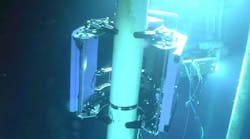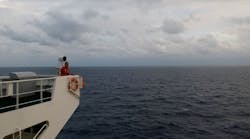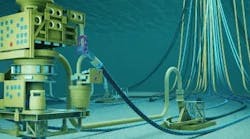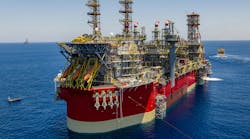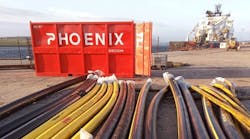While many flexible risers and a few steel catenary risers have been used over the past decade, the riser towers and suspended export lines to be installed this year on the Girassol Field in Angolan block 17 will be the first of their kind.
A consortium led by underwater robotics specialist Cybernetix has been awarded a contract for structural and temperature monitoring of the riser towers and export lines. The other partners in the consortium are Gaia Entreprise (responsible for design installation and data analysis) and Metravib (instrumentation and vibration).
To control the riser tower VIV (vortex-induced vibration) and structural load at the critical taper joint, the consortium designed a system employing strain gauges and motion reference units which will be installed by remotely operated vehicle (ROV) onto the riser towers and the 16-in. suspended export lines.
Data will be recorded every day to take into account cyclic events. The underwater recorders will be recovered every six months by ROV over a period of 1-2 years, and will be analyzed by the consortium on behalf of operator TotalFinaElf.
The motion reference units will provide information regarding natural vibration frequency and amplitude to cross-check fatigue analysis of the riser towers. The load cells on the taper joints will provide the strain and stress values which will be cross-checked with the natural frequency values given by the motion-recording unit.
Load cells on the 16-in. export lines will confirm the actual tension and bending moment in the 16-in. line due to catenary anchor leg buoy motion and flex-joint stiffness. Natural export line frequency will be defined and compared versus wave periods and catenary anchor leg buoy RAOs.
The contract also includes local temperature monitoring at the riser base on the outer skin of the pipe and underneath the insulation coating. The collected data will be recovered every 3-6 months or the system could be interrogated directly by the ROV. The system is also designed for online temperature monitoring via an acoustic modem.
Monitoring and data collection can be a very useful tool in reducing the design safety factor. According to international standards, the design of underwater systems must incorporate a safety coefficient of 10 for fatigue life calculation if the structure cannot be inspected and monitored. Obtaining reliable information to enhance the design of underwater structures is one of the key issues to reduce costs and define the technology required to dev-elop deeper subsea fields in a safe environment.
Similar monitoring systems could be used on drilling risers to allow larger displacement of the drilling rig, for instance during parallel pipe-line installation and drilling completion operations. This could be accomplished safely by controlling the load and bending transfer at the BOP and riser.


